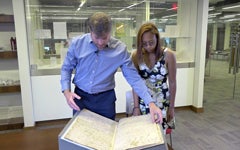
A recent gift to Georgetown University Library, now digitized and available online in DigitalGeorgetown, provides poignant and valuable insight into the Atlantic slave trade.
The Library recently received a logbook documenting the journey of the slave ship Mary from Providence, Rhode Island, to the west coast of Africa in 1795. It departed Africa with 142 enslaved individuals and arrived in Georgia on August 19, 1796.
The logbook offers an important view of the day-to-day life on board a slave trading ship. “Documentation about the slave trade is pretty extensive, but these records—extant logbooks—are fairly rare,” said Georgetown University History Professor Adam Rothman. There are only about a dozen surviving logbooks of slave ships that brought Africans to North America, although logbooks of slave ships that traveled to the Caribbean or Latin America are more common.
“Logbooks give a daily record of the routine business dealings, and experiences that took place on board a slave ship, including episodes of resistance and trauma,” Rothman added. While the Mary's shipping records are fairly well documented—it's included in the Trans-Atlantic Slave Database—this logbook is the only original record available from any of its journeys.
A Learning Tool
Rothman is using the logbook in his classes on Atlantic history and the history of slavery, and Georgetown students have the opportunity to see it in person. But students and researchers worldwide can also access the digitized logbook for their own research and learning. It is one of only a few existing slave ship logbooks that has been scanned and made available for online viewing.
“As historians, we need to find new ways to bring archival materials to life,” Rothman said. He's hoping to use the logbook in a digital storytelling project that will allow readers to follow the ship's journey on a map annotated with information showing the location of specific events along the route.
Another scholarly project underway is a transcription of the logbook by Georgetown graduate student Hillary MacKinlay (G'21). Not surprisingly for a document that's nearly 225 years old, some of the text is faded or written in difficult-to-read handwriting. A partial transcript of the logbook was published in the 1930s, but MacKinlay is preparing a new and more complete transcription.
“I think the process of acquiring and digitizing the logbook and having students involved in the production of projects around it is a great example of Slavery, Memory and Reconciliation in action,” Rothman said. “Georgetown has become an important site for the memory of the history of slavery, and the more dimensions we can add to that, the richer that site of memory will become.”
The gift to the Library was facilitated by Jack Pelose (C'19), a family friend of the donor. Pelose built a crate to safely transport the fragile logbook to Georgetown.
“Once it arrived, we realized the volume needed the attention of preservation specialists,” said Mary Beth Corrigan, curator of collections on Slavery, Memory, and Reconciliation in the Library's Booth Family Center for Special Collections. The preservation company took great care in cleaning the logbook. They also removed and re-sewed the binding and reconstructed deteriorating pages by applying a special Japanese paper that protects and strengthens the original document leaves. “The logbook is now stored in safe conditions so that it will be available to students and researchers at Georgetown for years to come,” Corrigan said.
Watch a video about the logbook and its preservation edited by student Yasmine Bouachri for the Spring 2020 AMST 272: Facing Georgetown's History class.
